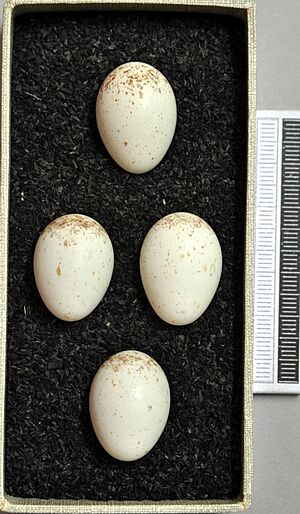Black wheatear facts for kids
Quick facts for kids Black wheatear |
|
|---|---|
 |
|
| at Merzouga, Morocco | |
| Conservation status | |
| Scientific classification |
The black wheatear (Oenanthe leucura) is a small bird that belongs to the Muscicapidae family, also known as Old World flycatchers. This bird is a type of wheatear. You can find black wheatears in southern Spain and parts of western North Africa.
Contents
About the Black Wheatear
How Scientists Name Animals
Scientists give every animal a special two-part name. This helps everyone know exactly which animal they are talking about. For the black wheatear, its scientific name is Oenanthe leucura.
A German scientist named Johann Friedrich Gmelin first officially described this bird in 1789. He gave it the name Turdus leucurus. The second part of its name, leucurus, comes from an old Greek word meaning "white-tailed." This name perfectly describes one of the bird's main features!
Later, scientists decided the black wheatear fit better into a different group of birds. So, it was moved to the genus Oenanthe.
Different Types of Black Wheatears
There are two main types, or subspecies, of the black wheatear:
- O. l. leucura (Gmelin, JF, 1789) – This type lives in Portugal, Spain, and southern France.
- O. l. riggenbachi (Hartert, EJO, 1909) – This type is found in northwest Africa.
What Does the Black Wheatear Look Like?
The black wheatear is a fairly large wheatear, growing to about 16 to 18 centimeters (about 6 to 7 inches) long.
Male and Female Birds
Male black wheatears are mostly black. They have a bright white patch on their back, near their tail. Their tail is also mostly white. Female black wheatears look similar to males, but their feathers are dark brown instead of black.
Comparing with Other Wheatears
There is another bird called the white-crowned wheatear (Oenanthe leucopyga). It lives in some of the same areas in Africa. You can tell the black wheatear apart by looking at its tail. The black wheatear has a black shape like an upside-down "T" on its white tail. The white-crowned wheatear only has a black center on its tail.
Also, the black wheatear never has a white crown on its head. Young white-crowned wheatears might not have a white crown either, so always check the tail!
Where Do Black Wheatears Live and What Do They Do?
Black wheatears like to live on cliffs and rocky slopes. They can be found in western North Africa and the Iberian Peninsula (Spain and Portugal). They used to live in southern France, but they don't breed there anymore.
These birds usually stay in the same area all year round. They build their nests in cracks and holes in rocks. A female black wheatear will lay about 3 to 6 eggs in her nest.
What do they eat? Black wheatears mainly eat insects. They have a loud song that sounds a bit like a thrush.



